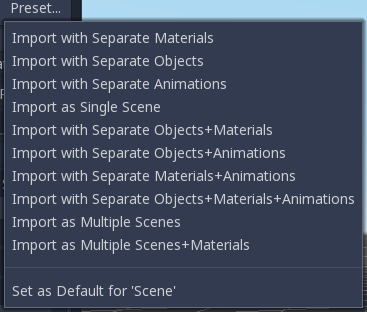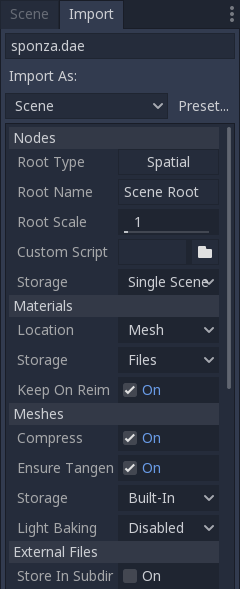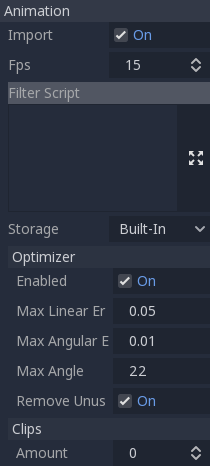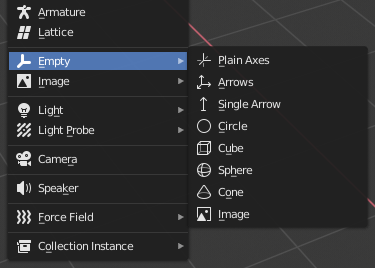Importing 3D scenes¶
Redot scene importer¶
When dealing with 3D assets, Redot has a flexible and configurable importer.
Redot works with scenes. This means that the entire scene being worked on in your favorite 3D DCC will be transferred as close as possible.
Redot supports the following 3D scene file formats:
glTF 2.0 (recommended). Redot has full support for both text (
.gltf) and binary (.glb) formats.DAE (COLLADA), an older format that is fully supported.
OBJ (Wavefront) format + their MTL material files. This is also fully supported, but pretty limited (no support for pivots, skeletons, animations, PBR materials, ...).
ESCN, a Redot-specific format that Blender can export with a plugin.
FBX, supported via the Open Asset Import library. However, FBX is proprietary, so we recommend using other formats listed above, if suitable for your workflow.
Just copy the scene file together with the texture to the project repository, and Redot will do a full import.
It is important that the mesh is not deformed by bones when exporting. Make sure that the skeleton is reset to its T-pose or default rest pose before exporting with your favorite 3D editor.
Exporting DAE files from Maya and 3DS Max¶
Autodesk added built-in COLLADA support to Maya and 3DS Max, but it's broken by default and should not be used. The best way to export this format is by using the OpenCollada plugins. They work well, although they are not always up-to date with the latest version of the software.
Exporting glTF 2.0 files from Blender¶
There are three ways to export glTF files from Blender. As a glTF binary (.glb file), glTF embedded (.gltf file),
and with textures (gltf + .bin + textures).
glTF binary files are the smallest of the three options. They include the mesh and textures set up in Blender. When brought into Redot the textures are part of the object's material file.
glTF embedded files function the same way as binary files. They don't provide extra functionality in Redot, and shouldn't be used since they have a larger file size.
There are two reasons to use glTF with the textures separate. One is to have the scene description in a text based format and the binary data in a separate binary file. This can be useful for version control if you want to review changes in a text based format. The second is you need the texture files separate from the material file. If you don't need either of those glTF binary files are fine.
Warning
Blend shape animations cannot be imported - they require manual animation within Redot.
Note
Blender versions older than 3.2 do not export emissive textures with the glTF file. If your model uses one and you're using an older version of Blender, it must be brought in separately.
By default, Blender has backface culling disabled on materials and will export materials to match how they render in Blender. This means that materials in Redot will have their cull mode set to Disabled. This can decrease performance since backfaces will be rendered, even when they are being culled by other faces. To resolve this, enable Backface Culling in Blender's Materials tab, then export the scene to glTF again.
Exporting DAE files from Blender¶
Blender has built-in COLLADA support, but it does not work properly for the needs of game engines and should not be used as is.
Redot provides a Blender plugin that will correctly export COLLADA scenes for use in Redot. It does not work in Blender 2.8 or newer, but there are plans to update it in the future.
Exporting ESCN files from Blender¶
The most powerful one, called godot-blender-exporter. It uses a .escn file, which is kind of another name for a .tscn file (Redot scene file); it keeps as much information as possible from a Blender scene. However, it is considered experimental.
The ESCN exporter has a detailed document describing its functionality and usage.
Exporting textures separately¶
While textures can be exported with a model in certain file formats, such as glTF 2.0, you can also export them separately. Redot uses PBR (physically based rendering) for its materials, so if a texturing program can export PBR textures, they can work in Redot. This includes the Substance suite, ArmorPaint (open source), and Material Maker (open source).
Note
For more information on Redot's materials, see Spatial Material.
Exporting considerations¶
Since GPUs can only render triangles, meshes that contain quads or N-gons have to be triangulated before they can be rendered. Redot can triangulate meshes on import, but results may be unpredictable or incorrect, especially with N-gons. Regardless of the target application, triangulating before exporting the scene will lead to more consistent results and should be done whenever possible.
To avoid issues with incorrect triangulation after importing in Redot, it is recommended to make the 3D DCC triangulate objects on its own. In Blender, this can be done by adding a Triangulate modifier to your objects and making sure Apply Modifiers is checked in the export dialog. Alternatively, depending on the exporter, you may be able to find and enable a Triangulate Faces option in the export dialog.
To avoid issues with 3D selection in the editor, it is recommended to apply the object transform in the 3D DCC before exporting the scene.
Import workflows¶
Redot scene importer allows different workflows regarding how data is imported. Depending on many options, it is possible to import a scene with:
External materials (default): Where each material is saved to a file resource. Modifications to them are kept.
External meshes: Where each mesh is saved to a different file. Many users prefer to deal with meshes directly.
External animations: Allowing saved animations to be modified and merged when sources change.
External scenes: Save each of the root nodes of the imported scenes as a separate scene.
Single scene: A single scene file with everything built in.

As different developers have different needs, this import process is highly customizable.
Import options¶
The importer has several options, which will be discussed below:

Nodes¶
Root Type¶
By default, the type of the root node in imported scenes is "Spatial", but this can be modified.
Root Name¶
Allows setting a specific name to the generated root node.
Root Scale¶
The scale of the root node.
Custom Script¶
A special script to process the whole scene after import can be provided. This is great for post processing, changing materials, doing funny stuff with the geometry etc.
Create a script like this:
tool # Needed so it runs in the editor.
extends EditorScenePostImport
func post_import(scene):
# Do your stuff here.
return scene # remember to return the imported scene
The post_import function takes the imported scene as argument (the
parameter is actually the root node of the scene). The scene that
will finally be used must be returned. It can be a different one.
Storage¶
By default, Redot imports a single scene. This option allows specifying that nodes below the root will each be a separate scene and instanced into the imported one.
Of course, instancing such imported scenes in other places manually works, too.
Materials¶
Location¶
Redot supports materials in meshes or nodes. By default, materials will be put on each node.
Storage¶
Materials can be stored within the scene or in external files. By default, they are stored in external files so editing them is possible. This is because most 3D DCCs don't have the same material options as those present in Redot.
When materials are built-in, they will be lost each time the source scene is modified and re-imported.
Note
Redot will not reimport materials that are stored in external files unless
you remove the associated .material file before reimporting.
To force reimporting materials every time the 3D scene is reimported, change the material storage mode in the 3D scene by selecting it in the FileSystem dock, going to the Import dock then setting Material > Storage to Built-In instead of Files.
Keep On Reimport¶
Once materials are edited to use Redot features, the importer will keep the edited ones and ignore the ones coming from the source scene. This option is only present if materials are saved as files.
Meshes¶
Compress¶
Makes meshes use less precise numbers for multiple aspects of the mesh in order to save space.
- These are:
Transform Matrix (Location, rotation, and scale) : 32-bit float to 16-bit signed integer.
Vertices : 32-bit float to 16-bit signed integer.
Normals : 32-bit float to 32-bit unsigned integer.
Tangents : 32-bit float to 32-bit unsigned integer.
Vertex Colors : 32-bit float to 32-bit unsigned integer.
UV : 32-bit float to 32-bit unsigned integer.
UV2 : 32-bit float to 32-bit unsigned integer.
Vertex weights : 32-bit float to 16-bit unsigned integer.
Armature bones : 32-bit float to 16-bit unsigned integer.
Array index : 32-bit or 16-bit unsigned integer based on how many elements there are.
- Additional info:
UV2 = The second UV channel for detail textures and baked lightmap textures.
Array index = An array of numbers that number each element of the arrays above; i.e. they number the vertices and normals.
In some cases, this might lead to loss of precision, so disabling this option may be needed. For instance, if a mesh is very big or there are multiple meshes being imported that cover a large area, compressing the import of this mesh(es) may lead to gaps in geometry or vertices not being exactly where they should be.
Ensure Tangents¶
If textures with normal mapping are to be used, meshes need to have tangent arrays. This option ensures that these are generated if not present in the source scene. Redot uses Mikktspace for this, but it's always better to have them generated in the exporter.
Storage¶
Meshes can be stored in separate files (resources) instead of built-in. This does not have much practical use unless one wants to build objects with them directly.
This option is provided to help those who prefer working directly with meshes instead of scenes.
Light Baking¶
Whether or not the mesh is used in baked lightmaps.
Disabled: The mesh is not used in baked lightmaps.
Enable: The mesh is used in baked lightmaps.
Gen Lightmaps: The mesh is used in baked lightmaps, and unwraps a second UV layer for lightmaps.
Note
For more information on light baking see Baked lightmaps.
External Files¶
Generated meshes and materials can be optionally stored in a subdirectory with the name of the scene.
Animation options¶
Redot provides many options regarding how animation data is dealt with. Some exporters (such as Blender) can generate many animations in a single file. Others, such as 3DS Max or Maya, need many animations put into the same timeline or, at worst, put each animation in a separate file.

Import of animations is enabled by default.
Attention
To modify animations from an imported 3D scene, you need to change the animation storage option from Built-In to Files in the Import dock. Otherwise, changes made to animations from Redot will be lost when the project is run.
FPS¶
Most 3D export formats store animation timeline in seconds instead of frames. To ensure animations are imported as faithfully as possible, please specify the frames per second used to edit them. Failing to do this may result in shaky animations.
Filter Script¶
It is possible to specify a filter script in a special syntax to decide which tracks from which animations should be kept.
The filter script is executed against each imported animation. The syntax consists of two types of
statements, the first for choosing which animations to filter, and the second for filtering
individual tracks within the matched animation. All name patterns are performed using a case
insensitive expression match, using ? and * wildcards (using String.matchn() under the
hood).
The script must start with an animation filter statement (as denoted by the line beginning with an
@). For example, if we would like to apply filters to all imported animations which have a name
ending in "_Loop":
@+*_Loop
Similarly, additional patterns can be added to the same line, separated by commas. Here is a
modified example to additionally include all animations with names that begin with "Arm_Left",
but also exclude all animations which have names ending in "Attack":
@+*_Loop, +Arm_Left*, -*Attack
Following the animation selection filter statement, we add track filtering patterns to indicate which animation tracks should be kept or discarded. If no track filter patterns are specified, then all tracks within the matched animations will be discarded!
It's important to note that track filter statements are applied in order for each track within the animation, this means that one line may include a track, a later rule can still discard it. Similarly, a track excluded by an early rule may then be re-included once again by a filter rule further down in the filter script.
For example: include all tracks in animations with names ending in "_Loop", but discard any
tracks affecting a "Skeleton" which end in "Control", unless they have "Arm" in their
name:
@+*_Loop
+*
-Skeleton:*Control
+*Arm*
In the above example, tracks like "Skeleton:Leg_Control" would be discarded, while tracks such
as "Skeleton:Head" or "Skeleton:Arm_Left_Control" would be retained.
Any track filter lines that do not begin with a + or - are ignored.
Storage¶
By default, animations are saved as built-in. It is possible to save them to a file instead. This allows adding custom tracks to the animations and keeping them after a reimport.
Optimizer¶
When animations are imported, an optimizer is run, which reduces the size of the animation considerably. In general, this should always be turned on unless you suspect that an animation might be broken due to it being enabled.
Clips¶
It is possible to specify multiple animations from a single timeline as clips. For this to work, the model
must have only one animation that is named default. To create clips, change the clip amount to something
greater than zero. You can then name a clip, specify which frames it starts and stops on, and choose whether
the animation loops or not.
Scene inheritance¶
In many cases, it may be desired to make modifications to the imported scene. By default, this is not possible because
if the source asset changes (source .dae, .gltf, .obj file re-exported from 3D modelling app), Redot will re-import the whole scene.
It is possible, however, to make local modifications by using Scene Inheritance. Try to open the imported scene and the following dialog will appear:

In inherited scenes, the only limitations for modifications are:
Nodes can't be removed (but can be added anywhere).
Sub-Resources can't be edited (save them externally as described above for this)
Other than that, everything is allowed!
Import hints¶
Many times, when editing a scene, there are common tasks that need to be done after exporting:
Adding collision detection to objects.
Setting objects as navigation meshes.
Deleting nodes that are not used in the game engine (like specific lights used for modelling).
To simplify this workflow, Redot offers several suffixes that can be added to the names of the objects in your 3D modelling software. When imported, Redot will detect suffixes in object names and will perform actions automatically.
Note
All the suffixes described below are case-sensitive.
Remove nodes (-noimp)¶
Objects that have the -noimp suffix will be removed at import-time no matter
what their type is. They will not appear in the imported scene.
Create collisions (-col, -convcol, -colonly, -convcolonly)¶
The option -col will work only for Mesh objects. If it is detected, a child
static collision node will be added, using the same geometry as the mesh. This
will create a triangle mesh collision shape, which is a slow, but accurate
option for collision detection. This option is usually what you want for level
geometry (but see also -colonly below).
The option -convcol will create a ConvexPolygonShape instead of
a ConcavePolygonShape. Unlike triangle meshes which can be concave,
a convex shape can only accurately represent a shape that doesn't have any
concave angles (a pyramid is convex, but a hollow box is concave). Due to this,
convex collision shapes are generally not suited for level geometry. When
representing simple enough meshes, convex collision shapes can result in better
performance compared to a triangle collision shape. This option is ideal for
simple or dynamic objects that require mostly-accurate collision detection.
However, in both cases, the visual geometry may be too complex or not smooth enough for collisions. This can create physics glitches and slow down the engine unnecessarily.
To solve this, the -colonly modifier exists. It will remove the mesh upon
importing and will create a StaticBody collision instead.
This helps the visual mesh and actual collision to be separated.
The option -convcolonly works in a similar way, but will create a ConvexPolygonShape instead.
The option -colonly can also be used with Blender's empty objects.
On import, it will create a StaticBody with
a collision node as a child. The collision node will have one of a number of predefined shapes,
depending on Blender's empty draw type:

Single arrow will create a RayShape.
Cube will create a BoxShape.
Image will create a PlaneShape.
Sphere (and the others not listed) will create a SphereShape.
When possible, try to use a few primitive collision shapes instead of triangle mesh or convex shapes. Primitive shapes often have the best performance and reliability.
Note
For better visibility in Blender's editor, you can set the "X-Ray" option on collision empties and set some distinct color for them in Blender's User Preferences > Themes > 3D View > Empty.
See also
See Collision shapes (3D) for a comprehensive overview of collision shapes.
Create a VehicleBody (-vehicle)¶
A mesh node with the -vehicle suffix will be imported as a child to a
VehicleBody node.
Create a VehicleWheel (-wheel)¶
A mesh node with the -wheel suffix will be imported as a child to a
VehicleWheel node.
Rigid Body (-rigid)¶
A mesh node with the -rigid suffix will be imported as a RigidBody.
Animation loop (-loop, -cycle)¶
Animation clips in the COLLADA document that start or end with the token loop or cycle
will be imported as a Redot Animation with the loop flag set.
Unlike the other suffixes described above, this does not require a hyphen.
In Blender, this requires using the NLA Editor and naming the Action with the loop or
cycle prefix or suffix.